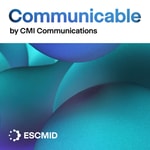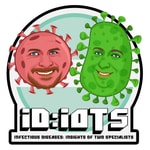Communicable – Détails, épisodes et analyse
Détails du podcast
Informations techniques et générales issues du flux RSS du podcast.

Communicable
CMI Communications
Fréquence : 1 épisode/14j. Total Éps: 29

Classements récents
Dernières positions dans les classements Apple Podcasts et Spotify.
Apple Podcasts
🇨🇦 Canada - medicine
21/06/2025#67🇩🇪 Allemagne - medicine
21/06/2025#95🇨🇦 Canada - medicine
12/06/2025#60🇩🇪 Allemagne - medicine
23/05/2025#62🇬🇧 Grande Bretagne - medicine
22/05/2025#61🇬🇧 Grande Bretagne - medicine
21/05/2025#69🇫🇷 France - medicine
17/05/2025#90🇬🇧 Grande Bretagne - medicine
16/05/2025#99🇫🇷 France - medicine
16/05/2025#69🇩🇪 Allemagne - medicine
15/05/2025#81
Spotify
Aucun classement récent disponible
Liens partagés entre épisodes et podcasts
Liens présents dans les descriptions d'épisodes et autres podcasts les utilisant également.
See all- https://www.msf.org/
35 partages
- https://doi.org/10.1016/S1473-3099
25 partages
- https://doi.org/10.1016/s0140-6736
22 partages
Qualité et score du flux RSS
Évaluation technique de la qualité et de la structure du flux RSS.
See allScore global : 73%
Historique des publications
Répartition mensuelle des publications d'épisodes au fil des années.
Communicable E9 - Avian flu: an update
Saison 1 · Épisode 9
lundi 9 septembre 2024 • Durée 50:25
The current H5N1 avian flu outbreak in poultry and dairy cows in the US has raised the alarm on bird flu and its transmission risk across species. At present, the virus has infected 100 million birds across 48 states and 196 dairy herds across 14 states. Luckily, the H5N1 avian flu, which is very lethal in birds, does not transmit easily into humans nor does it generally cause severe and systemic symptoms when humans are infected. Still, workers most exposed to these infected animals are testing positive with 14 human cases reported so far since 2022.
In this Communicable episode, hosts Angela and Nav are joined by avian flu expert Ron Fouchier (Erasmus MC Rotterdam, Netherlands) to discuss the most recent developments of the outbreak in the US and the potential risks H5N1 virus poses to humans. Understanding of the virus from its first reported outbreak in Hong Kong in 1997 to its global prevalence today is reviewed. While H5N1 bird flu does not pose as a global human health concern at present, unchecked practices in the dairy, meat, and agricultural industry sectors, in which workers are exposed to the virus, threaten to change the status quo. Learn why the threat is even more paramount in fall when human influenza or seasonal flu is widespread, and to what extent the government should also be involved in prevention and containment measures before it becomes, in Ron’s words, another “missed opportunity.”
This episode was edited by Kathryn Hostettler and peer-reviewed by Dr. Simon Galmiche of the Institut Pasteur, Université Paris Cité, Paris, France.
Literature
US Centers for Disease Control and Prevention (CDC). H5 Bird Flu: Current Situation. 2024. https://www.cdc.gov/bird-flu/situation-summary
Communicable E8 - The Nightmare Series, part 1: How to deal with Candida auris
Saison 1 · Épisode 8
lundi 26 août 2024 • Durée 59:24
Only known to us since 2008, Candida auris is an emerging fungal pathogen spreading quickly around the world; alarmingly, it is most commonly found in healthcare settings. C. auris sets itself apart from other Candida species with its unique tolerance to high saline and temperature environments and propensity to develop antifungal resistances that promote its survival in hospitals and healthcare facilities.
Hosts Emily McDonald and Navaneeth Narayanan are joined by fungal experts Dr. Jeffrey Rybak (St. Jude, Memphis TN) and Dr. Graham Snyder (UPMC, Pittsburgh PA) on their quest to better understand C. auris infections, the clinical challenges and knowledge gaps in C. auris research and discuss measures for prevention and containment on the levels of both the patient and the institution.
The recent emergence of C. auris as a multidrug-resistant nosocomial pathogen and its global prevalence has raised more questions than answers. Why now? Why healthcare facilities? Does climate change play a role? Are humans to blame? Tune in to find out what the experts have to say on these questions, and stay to learn about the current therapies available, what is in the antifungal pipeline and how to approach treatment from a stewardship standpoint.
This episode was produced by Angela Huttner, edited by Kathryn Hostettler and peer-reviewed by Dr. Claudio Neidhöfer of University Hospital Bonn, Germany.
Literature
Satoh K, Makimura K, Hasumi Y, et al. Candida auris sp. nov., a novel ascomycetous yeast isolated from the external ear canal of an inpatient in a Japanese hospital. Microbiol Immunol. 2009 Jan;53(1):41-4. doi: 10.1111/j.1348-0421.2008.00083.x
Lee WG, Shin JH, Uh Y, et al. First three reported cases of nosocomial fungemia caused by Candida auris. J Clin Microbiol. 2011 Sep;49(9):3139-42. doi: 10.1128/JCM.00319-11
Pfaller MA, Diekema DJ, Turnidge JD, et al. Twenty Years of the SENTRY Antifungal Surveillance Program: Results for Candida Species From 1997–2016. OFID. 2019 March;6(S1): S79–S94. doi: 10.1093/ofid/ofy358
Lockhart SR, Etienne KA, Vallabhaneni S, et al. Simultaneous Emergence of Multidrug-Resistant Candida auris on 3 Continents Confirmed by Whole-Genome Sequencing and Epidemiological Analyses. Clin Infect Dis. 2017 Jan 15;64(2):134-140. doi: 10.1093/cid/ciw691.
Clancy CJ, Nguyen MH. Emergence of Candida auris: An International Call to Arms. Clin Infect Dis. 2017 Jan 15;64(2):141-143. doi: 10.1093/cid/ciw696
Rybak JM, Cuomo CA, Rogers PD. The molecular and genetic basis of antifungal resistance in the emerging fungal pathogen Candida auris. Curr Opin Microbiol. 2022 Dec;70:102208. doi: 10.1016/j.mib.2022.102208
Communicable E7 - Melioidosis goes global
Saison 1 · Épisode 7
lundi 12 août 2024 • Durée 52:08
Once considered endemic only to tropical and subtropical climates such as Southeast Asia and northern Australia, melioidosis is expanding to non-endemic areas such as the southern US. Climate change is impacting infectious diseases, melioidosis being no exception. Now is the time to inform and prepare: as this Communicable episode’s title indicates, melioidosis is going global.
Join hosts Angela Huttner and Josh Davis on their in-depth exploration of melioidosis with invited experts Dr. Ella Meumann and Prof. Bart Currie from Royal Darwin Hospital, Darwin, Australia. Topics range from melioidosis discovery, clinical presentation, diagnostic approaches and host risk factors to the disease’s expanding endemicity.
Melioidosis is an infectious disease caused by the sapronotic agent Burkholderia pseudomallei and contracted by both people and animals through direct contact with contaminated soil, air or waters. Current burden estimates of 169’000 cases and 89’000 deaths per year are thought to be grossly underreported due to limited access to laboratory diagnostics and lack of clinical awareness. Experts call for melioidosis to be recognized as a neglected tropical disease in order to give this disease the urgent attention and resources it deserves.
This episode was edited by Kathryn Hostettler and peer-reviewed by Dr. Goulia Ohan of Yerevan State Medical University, Armenia.
Literature
Meumann EM and Currie BJ. Approach to melioidosis. CMI Comms 2024;1(1). doi: 10.1016/j.cmicom.2024.100008
Savelkoel J, Dance D. Alfred Whitmore and the Discovery of Melioidosis. Emerg Infect Dis. 2024;30(4):752-756. doi:10.3201/eid3004.230693
Limmathurotsakul D, Wongsuvan G, Aanensen D et al. Melioidosis Caused by Burkholderia pseudomallei in Drinking Water, Thailand, 2012. Emerg Infect Dis. 2014;20(2):265-268. doi: 10.3201/eid2002.121891
Petras JK, Elrod MG, Ty MC, et al. Locally acquired melioidosis linked to environment—Mississippi, 2020-2023. N Engl J Med. 2023;389:2355-2362. doi: 10.1056/NEJMoa2306448
Howes M and Currie BJ. Melioidosis and Activation from Latency: The “Time Bomb” Has Not Occurred. ASTMH. 28 May 2024;111(1): 156-160. doi 10.4269/ajtmh.24-0007
Communicable E6 - “Sneaky viruses”: an update on hepatitis B & C before World Hepatitis Day
Saison 1 · Épisode 6
jeudi 25 juillet 2024 • Durée 54:06
Responsible for 1.3 million deaths and 2.2 million new infections per year, viral hepatitis is the second leading cause of morbidity and mortality amongst all infectious diseases, just behind tuberculosis.
Hosts Angela Huttner and Oana Sandulescu welcome special guest and leading hepatitis expert, Professor Mojca Matičič, MD, PhD (Ljubljana, Slovenia), to refresh your knowledge on the pathogenesis of hepatitis B & C infections, review the latest direct-acting antiviral (DAA) therapies, map out some countries’ successful elimination initiatives, and understand challenges remaining for others.
In recognition of World Hepatitis Day this Sunday, 28 July, a day dedicated to raising awareness about viral hepatitis, we are releasing our latest episode a few days early. The World Hepatitis Day theme this year is: it’s time for action! The Communicable team urges our listeners to inform themselves and others, and to test, treat, and vaccinate against viral hepatitis.
This episode was peer reviewed by Dr. Liem Luong of CIC Cochin Pasteur, Hôpital Cochin-Port Royal, Assistance Publique-Hôpitaux de Paris, Paris, France.
Literature
World Hepatitis Day 2024: It’s time for action. Geneva: World Health Organization; 2024. https://www.who.int/campaigns/world-hepatitis-day/2024
“WHO sounds alarm on viral hepatitis infections claiming 3500 lives each day.” Geneva: World Health Organization; 9 April 2024. https://www.who.int/news/item/09-04-2024-who-sounds-alarm-on-viral-hepatitis-infections-claiming-3500-lives-each-day
Global hepatitis report 2024: action for access in low- and middle-income countries. Geneva: World Health Organization; 2024. doi: 10.2471/B09024.
The European Association of the Study of the Liver (EASL). EASL Congress Milan, Italy 5-8 June 2024. https://www.easlcongress.eu/
ESCMID. Cutting Edge Insights into Viral Hepatitis: Recent Scientific Breakthroughs and Clinical Updates. Lund, Sweden 13-14 June 2024. https://www.escmid.org/event-detail/cutting-edge-insights-into-viral-hepatitis-recent-scientific-breakthroughs-and-clinical-updates/
European Centre for Disease Prevention and Control (ECDC). ECDC Evidence brief: Prevention of hepatitis B and C in the EU/EEA. Stockholm: ECDC; 2024.
European Centre for Disease Prevention and Control. Hepatitis C. In: ECDC. Annual epidemiological report for 2022. Stockholm: ECDC; 2024.
Burnet Institute and Kirby Institute. Australia’s progress towards hepatitis C elimination: annual report 2022. Melbourne: Burnet Institute; 2022.
Maticic M, Pirnat Z, Leicht A, et al. The civil society monitoring of hepatitis C response related to the WHO 2030 elimination goals in 35 European countries. Harm Reduct J. 2020 Nov 19;17(1):89. doi: 10.1186/s12954-020-00439-3
Communicable E5 - Beauty is in the 'I' of the beholder: EUCAST updates
Saison 1 · Épisode 5
lundi 15 juillet 2024 • Durée 38:31
The ‘I’ (intermediate susceptibility) in a EUCAST-guided antibiogram never meant impending resistance to your antibiotic. It was never meant to make you find the one ‘S’ (invariably a carbapenem) and use it instead—even if many clinicians did.
In this episode of Communicable, hosts Marc Bonten and Angela Huttner welcome Profs. Christian Giske (outgoing chair) and Sören Gatermann (newly elected chair) of the European Committee on Antimicrobial Susceptibility Testing (EUCAST) to discuss its recent updates, including the new ‘susceptible dose dependent’ (SDD) label, and to shed light on common misconceptions around the way it sets breakpoints. Breakpoints for Pseudomonas aeruginosa are discussed, as are intravenous fosfomycin’s ‘disappearance’ from the breakpoints table and EUCAST’s new guidance on it. Episode peer-reviewed by Dr. Suzanne van Asten of Radboud University Medical Center.
Literature:
The European Committee on Antimicrobial Susceptibility Testing (EUCAST): https://www.eucast.org/
EUCAST guidance on use of fosfomycin i.v. breakpoints:
https://www.eucast.org/fileadmin/src/media/PDFs/EUCAST_files/Guidance_documents/Use_of_fosfomycin_iv_breakpoints_General_advice_20240528.pdf
In vitro synergy between fosfomycin and ceftazidime/avibactam:
Kroemer, Martens, Decousser et al. Evaluation of in vitro pharmacodynamic drug interactions of ceftazidime/avibactam and fosfomycin in Escherichia coli. J Antimicrob Chemother. 2023 Oct 3;78(10):2524-2534. doi: 10.1093/jac/dkad264
Communicable E4 - The BLING-3 trial & continuous beta-lactam infusion: should these results change your practice?
Saison 1 · Épisode 4
lundi 1 juillet 2024 • Durée 44:52
Hosts Angela Huttner & Erin McCreary welcome Prof. David Paterson (Singapore) and Prof. Josh Davis (Newcastle, Australia) to discuss the design and results of the BLING-3 trial, which compared continuous infusion of beta-lactam antibiotics to standard intermittent dosing in 7000 critically ill patients across 104 intensive-care units. In unadjusted analyses, the trial did not show a statistically significant mortality benefit with continuous infusion. Yet in prespecified adjusted analyses, there was a statistically significant reduction in mortality, and a meta-analysis of randomized trials published simultaneously with the BLING-3 trial showed the same. As the two ID doctors on the BLING team, Profs. Paterson and Davis offer context and insights into what these results mean and how they might affect your clinical practice. Episode peer-reviewed by Dr. Mia Lidén of Charité – Universitätsmedizin Berlin.
Literature
- BLING-1: Dulhunty et al. Continuous infusion of beta-lactam antibiotics in severe sepsis: a multicenter double-blind, randomized controlled trial. Clin Infect Dis. 2013 Jan;56(2):236-44. DOI: 10.1093/cid/cis856
- BLING-2: Dulhunty et al. A Multicenter Randomized Trial of Continuous versus Intermittent β-Lactam Infusion in Severe Sepsis. Am J Respir Crit Care Med. 2015 Dec 1;192(11):1298-305. DOI: 10.1164/rccm.201505-0857OC
- BLING-3: Dulhunty et al. Continuous vs Intermittent β-Lactam Antibiotic Infusions in Critically Ill Patients With Sepsis: The BLING III Randomized Clinical Trial. JAMA. 2024 Jun 12:e249779.DOI: 10.1001/jama.2024.9779
- Meta-analysis: Abdul-Aziz et al. Prolonged vs Intermittent Infusions of β-Lactam Antibiotics in Adults With Sepsis or Septic Shock: A Systematic Review and Meta-Analysis. JAMA. 2024 Jun 12:e249803. DOI: 10.1001/jama.2024.9803
Communicable E3 - The new WHO Priority Pathogens List: which bugs to target first?
Saison 1 · Épisode 3
lundi 17 juin 2024 • Durée 42:58
What are WHO's most wanted bacterial pathogens in 2024? Hosts Angela Huttner & Oana Sandulescu welcome guests Dr. Hatim Sati of the World Health Organisation (WHO) and Dr. Erin Duffy (CARB-X) to discuss WHO’s new Priority Pathogens List. Developed by WHO and a panel of global experts, the List identifies the ‘top’ bacteria for which research & development are of critical, high, and medium priority, and thus serves as a framework for resource allocation and public-policy guidance. Episode peer-reviewed by Dr. Galadriel Pellejero of Lozano Blesa Clinical Hospital, Zaragoza, Spain.
Literature:
WHO bacterial priority pathogens list, 2024: Bacterial pathogens of public health importance to guide research, development and strategies to prevent and control antimicrobial resistance.
Communicable E2 - Phage therapy: does it work and will we have access?
Saison 1 · Épisode 2
lundi 3 juin 2024 • Durée 54:00
In this episode, hosts Josh Davis (Newcastle, Australia) and Angela Huttner (Geneva, Switzerland) interview the phage ‘microbiologist-clinician duo’, Drs. Shawna McCallin and Lorenz Leitner (Balgrist Hospital, Zurich, Switzerland). They explore the history of phages, the process of bringing phage therapy to a patient, potential resistance to phages, availability of individualized therapy versus phage cocktails, and the place of phage therapy in the future. Drs. Leitner and McCallin reflect on the challenges and lessons of their recently published randomized trial comparing phage therapy to antibiotics for urinary tract infection. Episode peer-reviewed by Dr. Olivia Funk of Long Island University.
Literature
Leitner L, Ujmajuridze A, Chanishvili N et al. Intravesical bacteriophages for treating urinary tract infections in patients undergoing transurethral resection of the prostate: a randomised, placebo-controlled, double-blind clinical trial. Lancet Infect Dis. 2021 Mar;21(3):427-436. doi: 10.1016/S1473-3099(20)30330-3.
Communicable E1 - Late-breaker clinical trial results from ESCMID Global 2024: Should they change your practice?
Saison 1 · Épisode 1
vendredi 10 mai 2024 • Durée 58:02
CMI Communications editors Angela Huttner, Marc Bonten, and Erin McCreary discuss late-breaker clinical trials presented at ESCMID Global (ECCMID) in Barcelona, providing insights into the trials’ designs, results, and implications. The DOTS trial compared two doses of long-acting dalbavancin to standard of care in patients with complicated S. aureus bacteremia. GAME-CHANGER compared cefiderocol to standard of care for gram-negative infections. PediCAP compared oral step-down therapy with amoxicillin with or without clavulanic acid at shorter durations to the current WHO-recommended standard of five days of intravenous antibiotic therapy in children with severe pneumonia. Additional results from the MULTICAP and CLEEN trials, the CAMERA-2 follow-on in vitro analysis, and the Burkina Faso Escherichia coli transmission study are also discussed. Episode peer-reviewed by Dr. Yousra Kherabi.
Communicable E10 - Pipeline update: new antibiotics & other antimicrobials that you might actually use
Saison 1 · Épisode 10
lundi 23 septembre 2024 • Durée 52:37
On the verge of a post-antibiotic reality, there is an urgent clinical need for new antibiotics. Luckily, new candidates are in the pipeline and older agents are getting a second breath of life through combination therapy.
In this episode of Communicable, host Erin McCreary invites Dr. Markus Zeitlinger of the University of Vienna (Austria) and scientific expert for the European Medicines Agency (EMA) and Dr. Michael Dudley, president and CEO of Qpex Biopharma, to discuss antimicrobials in the clinical development pipeline. Together they unpack how the WHO curate the priority list of pathogens and how companies adapt such lists into their antimicrobial development business plans. They also discuss the unique challenges and complexities of developing antibiotics, from return on investments and defining the ‘novelty’ of an agent to the conundrum of balancing post-market approval and antimicrobial stewardship. Beta-lactamase inhibitors and oral carbapenems in the pipeline targeting ‘the big three’ (Enterobacterales, Pseudomonas and Acinetobacter) are the primary focus.
This episode was edited by Kathryn Hostettler and peer-reviewed by Dr. Benjamin Berinson of the Medical Centre Hamburg-Eppendorf (UKE), Germany. For more information on the WHO Priority Pathogens List and its 2024 update, check out our previous episode, Communicable E3 (see Literature).
Literature
Communicable E3 - The New WHO Priority Pathogens List: which bugs to target first? 17 June 2024. https://communicable.transistor.fm/episodes/communicable-e3-the-new-who-priority-pathogens-list-which-bacteria-to-target-first
WHO Bacterial Priority Pathogens List, 2024: bacterial pathogens of public health importance to guide research, development and strategies to prevent and control antimicrobial resistance. Geneva: World Health Organization; 17 May 2024. https://www.who.int/publications/i/item/9789240093461
C. Le Terrier et al, NDM-9 resistance to taniborbactam. Lancet Infect Dis 23, 401-402 (2023). doi 10.1016/S1473-3099(23)00069-5
P. B. Eckburg et al, Oral Tebipenem Pivoxil Hydrobromide in Complicated Urinary Tract Infection. N Engl J Med 386, 1327-1338 (2022). doi: 10.1056/NEJMoa2105462
A Study of Oral Tebipenem Pivoxil Hydrobromide (TBP-PI-HBr) Compared to Intravenous Imipenem-cilastatin in Participants With Complicated Urinary Tract Infection (cUTI) or Acute Pyelonephritis (AP) (PIVOT-PO). https://clinicaltrials.gov/study/NCT06059846
Meiji Seika Pharma Initiated the Global Phase III Clinical Trials of OP0595, a Novel beta-Lactamase Inhibitor for Combatting Antimicrobial Resistance (AMR). Tokyo: Meiji Seika Pharma Ltd; 26 April 2023. https://www.meiji.com/global/news/2023/pdf/230426_01.pdf









